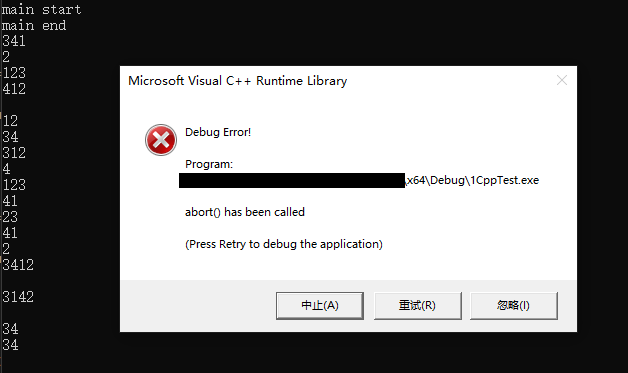中文文档:原子操作std::atomic(可以无锁并发编程)
一、创建线程
#include <iostream>
#include <thread>
void fun1()
{
for (int i = 0; i < 10; i++)
{
std::cout << "1" << "2" << std::endl;
}
}
void fun2()
{
for (int i = 0; i < 10; i++)
{
std::cout << "3" << "4" << std::endl;
}
}
int main()
{
std::cout << "main start" << std::endl;
std::thread t1(fun1);
std::thread t2(fun2);
std::cout << "main end" << std::endl;
return 0;
}

可以看到,这样创建线程是有问题的,因为在创建了线程后线程开始执行,但是主线程main()并没有停止脚步,仍然继续执行然后退出,此时线程对象还是joinable(可结合的)的,线程仍然存在但指向它的线程对象已经销毁,所以会抛出异常。
如何保证子线程执行完了退出后再退出主线程呢?
1.1 解决方法1:join()
使用join接口可以解决上述问题,join的作用是让主线程等待直到该子线程执行结束(因此调用join会阻塞)。需要注意的是线程对象执行了join后就不再joinable了,所以只能调用join()一次。创建了线程之后并不是调用join或detach才会执行线程,也许调用join或detach之前线程已经执行完了。只要创建了线程对象(传递“函数名/可调用对象”作为参数的情况下),线程就开始执行(std::thread 有一个无参构造函数重载的版本,不会创建底层的线程,只是一个空的对象。)。
- join阻塞代码演示
#include <iostream>
#include <thread>
#include <chrono>
#include <vector>
using namespace std;
void work()
{
this_thread::sleep_for(chrono::seconds(5));
}
int main()
{
clock_t start = clock();
vector<thread> t;
for (int i = 0; i < 5; i++)
{
t.emplace_back(thread(work));
//t[i].join(); //join放在这里程序运行时间为25s多一点
}
for (int i = 0; i < 5; i++)
{ //join放在这里程序运行时间为5s多一点
t[i].join(); //join会阻塞住,因此需要放在创建线程的循环外边才能达到多线程的效果
}
cout << clock() - start;
}
- join使用演示
int main()
{
std::cout << "main start" << std::endl;
std::thread t1(fun1);
std::thread t2(fun2);
std::cout << "***" << std::endl;
t1.join();
std::cout << "@@@" << std::endl;
t2.join();
std::cout << "main end" << std::endl;
//std::thread(fun1).join(); //和上面两句代码等价
return 0;
}

1.2 解决方法2:detach()
detach是用来和线程对象分离的,这样线程可以独立地执行,不过这样由于没有thread对象指向该线程而失去了对它的控制,当对象析构时线程会继续在后台执行,但是当主程序退出时并不能保证线程能执行完。如果没有良好的控制机制或者这种后台线程比较重要,最好不用detach而应该使用join。
int main()
{
std::cout << "main start" << std::endl;
std::thread t1(fun1);
std::thread t2(fun2);
std::cout << "***" << std::endl;
t1.detach();
std::cout << "@@@" << std::endl;
t2.detach();
std::cout << "main end" << std::endl;
return 0;
}
由结果可见线程并没有执行完而退出

二、线程调用特殊函数
2.1 线程调用的函数含有参数
多线程中的函数参数如果为引用必须使用std::ref(函数式编程的参数默认使用拷贝方式),多线程中的函数参数如果为IO(socket应该也需要,没有测试过)必须使用移动语义(std::move),避免多个对象同时读写同一个IO缓冲
#include <thread>
#include <iostream>
void fun(int& num) //参数为int&
{
while (num < 10)
std::cout << num++;
}
int main()
{
int num = 0;
std::thread t1(fun, std::ref(num));
std::thread t2(fun, std::ref(num));
t1.join();
t2.join();
return 0;
}
2.2 线程调用成员函数
#include <iostream>
#include <thread>
class A
{
public:
void display(int a) { std::cout << a << '
'; }
};
int main()
{
A a;
std::thread t(&A::display, a, 3); //第一个参数必须带&,第二个可带可不带,第二个参数之后是调用函数的实参
t.join();
}
三、多线程执行含有返回值的函数,获取函数返回值
转载:C++ 中 async、packaged_task、promise 区别及使用
-
将函数的返回值设置为输出参数
-
使用std::future、std::promise和packaged_task
-
使用lambda表达式获取函数返回值(如果线程执行太慢,主线程执行cout的时候result没有计算出来会出问题)。
lambda表达式
#include <iostream>
#include <thread>
int f(int a, int b)
{
return a + b;
}
int main()
{
int result = 0;
std::thread* t;
t = new std::thread([&] { result = f(2, 3); });
t->join();
std::cout << result; //result = 5
return 0;
}
std::async和std::future的使用
转载:C++STL 线程:Future, Promise and async()
std::async()与std::thread()最明显的不同就是async只是创建异步任务,不一定创建线程。async()默认创建线程,可以设置第一个参数来决定是否创建线程。
- async函数原型:
std::async(std::launch::deferred,func,...) //不创建线程,直到调用get()在主线程执行调用的入口函数
std::async(std::launch::async,func,...) //会创建线程,且立即执行
std::async(std::launch::async | std::launch::deferred,func,...) //和std::launch::async一样,创建线程
std::async(func,...) //和std::launch::async一样,创建线程
- 获取函数返回值示例代码:
//async的使用,配合future直接获取多线程中所调用函数的返回值
#include <iostream>
#include <thread>
#include <future>
int f(int a, int b)
{
using namespace std::chrono_literals;
std::this_thread::sleep_for(5s); //睡眠五秒
return a + b;
}
int main()
{
std::future<int> retVal = std::async(f, 2, 4);
std::cout << "start" << '
';
std::cout << retVal.get(); //会阻塞,即主线程需要子线程执行完从而得到返回值
std::cout << "end" << '
';
return 0;
}
//async,future析构阻塞问题
#include <iostream>
#include <thread>
#include <future>
int main()
{
auto sleep = [](int s) { std::this_thread::sleep_for(std::chrono::seconds(s)); };
clock_t start = clock();
{
std::async(std::launch::async, sleep, 5); // 临时对象被析构,阻塞 5s
std::async(std::launch::async, sleep, 5); // 临时对象被析构,阻塞 5s
//auto f1 = std::async( std::launch::async, sleep, 5 );
//auto f2 = std::async( std::launch::async, sleep, 5 );
}
std::cout << (clock() - start) / CLOCKS_PER_SEC << std::endl;
return 0;
}
std::promise和std::future的使用
promise作为参数应该以引用的形式传入(),因此需要使用std::ref()
future和promise的作用是在不同线程之间传递数据。使用指针也可以完成数据的传递,但是指针非常危险,因为互斥量不能阻止指针的访问;而且指针的方式传递的数据是固定的,如果更改数据类型,那么还需要更改有关的接口,比较麻烦;promise支持泛型的操作,更加方便编程处理。std::promise的作用就是提供一个不同线程之间的数据同步机制,它可以存储一个某种类型的值,并将其传递给对应的future, 即使这个future不在同一个线程中也可以安全的访问到这个值。
示例代码:
//promise的使用,多线程中的函数所使用的参数需要其他线程返回
//1.子线程使用主线程传入的值
#include <thread>
#include <future>
#include <iostream>
void task(/*std::future<int> i*/std::promise<int>& i)
{
std::this_thread::sleep_for(std::chrono::seconds(1));
std::cout << i.get_future().get();
//std::cout << i.get() ; // 阻塞,直到 p.set_value() 被调用
}
int main()
{
//lambda表达式和函数效果一样
//auto task = [](std::future<int> i)
//{
// std::this_thread::sleep_for(std::chrono::seconds(3));
// std::cout << i.get() << std::flush; // 阻塞,直到 p.set_value() 被调用
//};
std::promise<int> p;
//std::thread t(task, p.get_future());
std::thread t(task, std::ref(p));
p.set_value(5);
t.join(); //调用完join后执行task(),因此在这里会阻塞
return 0;
}
//2.主线程使用子线程得到的值
//#include <iostream>
//#include <future>
//#include <thread>
//
//void task(std::promise<int>& i)
//{
// //dosomething
// int value = 8;
// i.set_value(value);
//}
//
//int main()
//{
// std::promise<int> pro;
// std::future<int> ret = pro.get_future();
//
// std::thread t(task, std::ref(pro));
// t.join();
//
// std::cout << "get value:" << ret.get() << std::endl;
//
// system("pause");
// return 0;
//}
std::packaged_task和std::future的使用
std::packaged_task的作用就是提供一个不同线程之间的数据同步机制,std::packaged_task本身和线程没有关系,它只是关联了一个std::future的仿函数。需要显式的调用或者传递给std::thread进行异步调用,所以它更灵活(可以选择什么时候开始任务)。
std::packaged_task 对象内部包含了两个最基本元素
-
被包装的任务(stored task),任务(task)是一个可调用的对象,如函数指针、成员函数指针或者函数对象
-
共享状态(shared state),用于保存任务的返回值,可以通过 std::future 对象来达到异步访问共享状态的效果。
示例代码
//packaged_task的使用,直接得到多线程调用函数的返回值
#include <iostream> // std::cout
#include <utility> // std::move
#include <future> // std::packaged_task, std::future
#include <thread> // std::thread
int fun(int a)
{
std::this_thread::sleep_for(std::chrono::seconds(3));
return 2 * a;
}
int main()
{
std::packaged_task<int(int)> foo(fun);
std::future<int> ret = foo.get_future();
std::thread t(std::move(foo), 19);
t.join(); //阻塞,调用fun函数得到返回值
std::cout << ret.get();
return 0;
}
async、promise、paceaged_task三者的区别与联系
-
用 std::async 来做简单的事情,例如异步执行一个任务。但是要注意 std::future 析构阻塞的问题。
-
std::packaged_task 能够很轻松的拿到 std::future,选择是否配合 std::thread 进行异步处理。同时没有析构阻塞的问题。
-
std::promise 是三者中最底层的能力,可以用来同步不同线程之间的消息